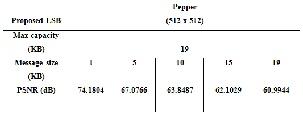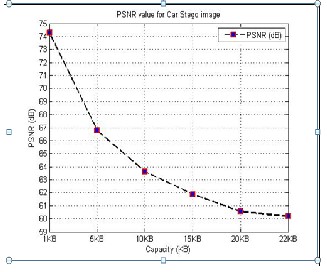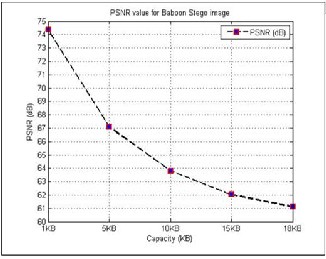
International Journal of Scientific & Engineering Research, Volume 5, Issue 4, April-2014 285
ISSN 2229-5518
A NEW COLOUR IMAGE STEGANOGRAPHY USING LSB APPROACH WITH HALFTONING DETERMINATION EMBEDDING POSITION
Reband Jamil Hassan1, Ghazali Sulong2
1, 2 Faculty of Computing, Univ ersiti Teknologi Malaysia (UTM) 81310, Johor Bahru, Malaysia
E-mail: 1 reband.jamil@gmail.com, 2 ghazali@utmspace.edu.my
67dB, and was able to withstand against the Chi-square attack.
Index Terms— Steganography, Cover image, Stego image , Halftoning, LSB, Secret message.
—————————— ——————————
1 INTRODUCTION
Teganography is a technique used to hide a message or disguise information from the view of all but other the authentic receiver
[7]. The term steganography literally means “covered writing” [3,5]. Before the age of computer, steganography is used by people to secret- ly hide messages in various objects in order to disguise these messages from third party viewing. In today’s world the technique is used ensure privacy, anonymity and secure communication of sensitive data on internet. The main idea of this technology is to hide a message inside other content which is less important, thereby drawing attention away from the hidden message.
The technique is a branch of cryptography but unlike the original technique which encrypts messages and makes them unreadable, ste- ganography conceals the presence of the message entirely. The tech- nique can be applied to text, audio, video or image media.
In steganography the carrier media include: audio, text, video, and any other type of digital medium [6]. Audio steganography hides mes- sages inside an audio medium. In this type the hidden audio must re- main undetectable; the techniques include Amplitude Modification, Spread Spectrum Coding, Echo Hiding, Phase Coding, and Least Sig-
nificant Bit (LSB).
For text Steganography the carrier medium is text file. Many tech- niques can be used for text steganography including Feature coding, Word-Shift Code, Line-Shift Code, syntactic, cover generation, and semantic techniques [3,11,13]. Image Steganography used image files as carrier mediums to hide the secret message. The Least Significant Bit (LSB) technique is one of the image steganography techniques used for digital files [3,8]. The method is good for its simple embed- ding and de-embedding processes.
The Least Significant Bit (LSB) approach is the most commonly used technique of image steganography. It is simple to use and the resulted file does not arouse third party suspicion since the method is based on dismissing least significant bits of all bytes and replacing these bits of embedded information [4]. The technique provides better imperceptibility of image without distortion and increase ca- pacity without affecting the image quality.
The main drawbacks of Least Significant Bit (LSB) technique of image steganography it is vulnerable to statistical [1] and visual attack [14] and still suffers the problem of security [4]. The ap- proach cannot be used with GIG or JPEG files formats. The ap- proach inserts a bit stream message in the continuous pixels of the host image whenever examine transferring image for suspicious data which consequently reveals the secret data to third parties. The origi- nal message is required to extract data from cover message [4].
IJSER © 2014 http://www.ijser.org
International Journal of Scientific & Engineering Research, Volume 5, Issue 4, April-2014 286
ISSN 2229-5518

This research is an attempt to improve the security level of LSB
technique of image steganography by using halftoning technique
(2x2 dithering) that embeds a secret message into RGB colour host
image.
There are several similar researches by different authors on the subject of image steganography and Least Significant Bit (LSB) approach in particular.
Reddy et al. (2011) proposed a method for image steganography called the Selected Least Significant Bits method (SLSB). SLSB utilizes the color component of insignificant pixels so that the chang- es caused by the embedded data will not be noticed and then altering the remaining components of the pixel color so that they take on the color nearest the original color. The method decreases the chances of secret data exposure to third parties but the result of the evaluation shows a very low PSNR value.
Maryam Habib (2013) proposed a method to increase the robust- ness of text message steganography by hiding the message in appro- priate places within the image using shuffled leaping frog algorithm (SLFA). The result obtained by applying the proposed method on 20 sample images shows the appropriateness of method but the pro- posed technique still suffers the problem of security.
The work of Karim et al., (2011) proposed a new approach for LSB based image steganography using secret key. The technique is to store hidden messages into different.
LSB image positions using secret key. However PSNR value found in the evaluation was relatively low 53.76-53.79 and the ca-
pacity is only 24bits/pixel.
In general, the security level of LSB method of image steganog- raphy is still relatively low despite all the attempts to improve it in the past. The method is good for its simplicity of usage but the aspect of security still needs to be improved.
The procedure begins by defining halftone dither (2x2) matrix then dividing the host image into R, G and B channels. The B chan- nel is selected and divided into Q blocks of size (2x2) pixels. A block of Q blocks is selected and compared with the defined halftone dith- er matrix in order to create the halftone image, as shown Figure 1.
Figure 1 Halftone image creation
The following steps explain how the secret message embedding algorithm works:
Input: Host image, Halftone image. Output: Stego image.
.
Step 1: Read Host image.
Step 2: Divide host image into R, G and B channels.
Step 3: Select B channel and divide it into Q blocks of (2x2) pix- els.
Step 4: Read Halftone image.
Step 5: Find the summation for Halftone_Key black and white pixels as BP and WP respectively.
IJSER © 2014 http://www.ijser.org
International Journal of Scientific & Engineering Research, Volume 5, Issue 4, April-2014 287
ISSN 2229-5518
Step 6: if BP is greater than or equal to WP then, set SP to zero;
otherwise, set SP to one and go to step 11.
Step 7: Divide Halftone image into Q blocks of (2x2) pixels.![]()
Step 8: Set , and ![]() = length of the message vectors.
= length of the message vectors.
Step 9: Select K block of Q blocks of each of B channel and
Halftone image.
Step 10: Select a pixel of K blocks of each of B channel and Halftone image and call them ![]() and
and![]() , respectively.
, respectively.
Step 11: If ![]() , proceed to the next step; otherwise, go to step 15.
, proceed to the next step; otherwise, go to step 15.
Step 12: If ![]() then, go to step 15; otherwise, proceed to next step.
then, go to step 15; otherwise, proceed to next step.
Step 13: Select C bit of secret message vectors.
Step 14: If the selected bit is equal to 0 , change the ![]() to bit stream and change its LSB to 0 and proceed to next step; otherwise, change its LSB to 1 and proceed to next step. Figure
to bit stream and change its LSB to 0 and proceed to next step; otherwise, change its LSB to 1 and proceed to next step. Figure
1.2 shows embedding four bits of the secret message into four pixels of B channel. (a) Four bits of secret message. (b) Four pix- els bit stream of B channel before embedding. (c) Four pixels bit stream of B channel after embedding.
Figure 1.2 four bits of secret message and four pixels bit stream of
B channel before and after embedding.
Step 15: Convert back ![]() value to decimal and save it in a new matrix called stego_B(512x512).
value to decimal and save it in a new matrix called stego_B(512x512).
Step 16: Increment C by one.
Step 17: If the selected block pixels are all selected , proceed to the next step; otherwise, go back to step 10.
Step 18: If K < Q , increment K by one and go back to step 9;
otherwise, proceed to the next step.
Step 19: Stego_B (512x512) is obtained.
Step 20: Merge R, G channel with Stego_B (512x512) matrix to obtain RGB Stego image.
Step 21: RGB Stego image.
On receiving the message the secret message will be extracted in the following steps:
Input: Stego image, Halftone_Key, ML (Message Length). Output: Extracted Secret Message.
Step 1: Read Stego image.
Step 2: Divide Stego image into R, G and B channels.
Step 3: Select B channel and divide it into Q blocks of (2x2)
pixels.
Step 4: Read Halftone_Key.
Step 5: Find summation for Halftone_Key for each of black and white pixels as BP and WP respectively.
Step 6: if BP is greater than or equal to WP then, set SP to zero;
otherwise, set SP to one and go to step 11.
Step 7: Divide Halftone_Key into Q square blocks of (2x2) pixels. Step 8: Set ![]() , where K represents the selected block and C represents the extracted message bit position.
, where K represents the selected block and C represents the extracted message bit position.
Step 9: Select K block of Q blocks of each of B channel and
Halftone_Key.
Step 10: Select a pixel of K block of each of B channel and Halftone_Key at a time and call them ![]() and
and![]() , respectively.
, respectively.
Step 11: If ![]() , proceed to next step; otherwise, go to step 15.
, proceed to next step; otherwise, go to step 15.
Step 12: If ![]() , go to step 17; otherwise, proceed to next step.
, go to step 17; otherwise, proceed to next step.
Step 13: Convert ![]() to bit stream and extract its LSB bit.
to bit stream and extract its LSB bit.
Step 14: Save the extracted LSB bit into a new matrix called A (1, ML).
Step 15: increment C by one.
Step 16: If the selected block pixels are all selected , proceed to next step; otherwise, go back to step 10.
Step 17: If ![]() or
or ![]() , proceed to next step; otherwise,
, proceed to next step; otherwise,
increment K by one and go back to step 9.
Step 18: Matrix A (1, ML) is obtained. Step 19: Convert matrix A to ASCII code. Step 20: Convert ASCII code to character. Step 21: Extracted Secret message.
IJSER © 2014 http://www.ijser.org
International Journal of Scientific & Engineering Research, Volume 5, Issue 4, April-2014 288

ISSN 2229-5518
5 DATASET
The data used in this study will be explained briefly. These data consist of six standard color images of (512 × 512) pixels including: Lena, Baboon, Pepper, Airplane, Car and Sailboat. These images are used as cover images. In addition, these images contain different color
images and help to obtain precise results for evaluating the impercepti-
bility. Then, an attack is applied on these images after the embedding process. Usually, these images are used in all studies that deal with data hiding.
The proposed method obtained sufficient result, and can be evaluated for imperceptibility, capacity, robustness and security. The analysis results are discussed in the following subsections.
In this study, the quality of the image is estimated by PSNR metric. A greater PSNR value indicates a lower degree of generated image distortion by embedding algorithm.
The results of the proposed LSB technique used on different images of Lena, Baboon, Pepper, Airplane, Car and Sailboat, are shown inTable (1, 2, 3, 4, 5 and 6 respectively) as cover images. The results show that the proposed method produces high PSNR values in all the various images used in the experiment.
Table 1 PSNR for stego Lena image
Table 2 PSNR for stego Baboon image
Table 3 PSNR for stego Pepper image
Table 4 PSNR for stego Airplan image
Table 5 PSNR for stego Car image
Table 6 PSNR for stego Sailboat image
In Lena image the number of black pixels is (121534) and white pixels is (140610) therefore white pixel is selected for embedding purpose based on its larger number. In Baboon image the number of black pixels is (113263) and that of white pixel is (148881) so white pixel is selected for embedding. In Pepper image the number of black pixels is (157529) and number of white pixel is (104615) so black pixel is selected. And for the Airplane image number of black pixels is (23683) and white pix- els is (238461) so white pixel is selected. The same applies to Sailboat, in which the number of black pixels is (109121) and that of white pixel are (153032) hence the white pixel is selected.
Since the PSNR value in all of the experiments is above 36 dB, the changes in the images are not detectable by the human eye as shown in Figure (2,3,4,5,6 and 7).
IJSER © 2014 http://www.ijser.org
International Journal of Scientific & Engineering Research, Volume 5, Issue 4, April-2014 289
ISSN 2229-5518

Figure 2 Performance of PSNR for Car Stego image
Figure 3 Performance of PSNR for Sailboat Stego image
Figure 4 Performance of PSNR for Airplane Stego image
Figure 5 Performance of PSNR for Lena Stego image

Figure 6 Performance of PSNR for Baboon Stego image
Figure 7 Performance of PSNR for Pepper Stego image
IJSER © 2014 http://www.ijser.org
International Journal of Scientific & Engineering Research, Volume 5, Issue 4, April-2014 290
ISSN 2229-5518
The technique of Chi-square is one of the most reliable attack method measuring the robustness of secret message in Stego- image due to its ability to determine the probability of hidden messages without physically tempering the image [10].
The Lena image was used in this research for chi-square test. The percentage of the image was varied from 0 to 100, as shown in Figure 8. The probability of secret message in the image range from 0 to the value obtained from Chi-square attack. A value equal to zero indicates no secret message and higher certainty is achieved as the value approaches one. For all the percentages of the image the probability is about zero which indicates the cover image contains no hidden message.
Figure 8 result of Chi-square attack on original Lena image
![]()
![]()
The Airplane image 512x 512 in size with a maximum size of 29KB was used for benchmarking against a previous work Ahmed.A.M. (2012). A positive result was obtained as shown in Table 7 with a clear improvement in both the PSNR and capacity using the Airplane image of same size of message .
![]()
Table 7 shows the benchmark proposed method with
Ahmed.A.M. (2012)
7. CONLUSION
The research proposed a new colour image steganography method using LSB approach with Halftoning technique (2x2 dithering) that embeds a secret message into RGB colour host image. The proposed algorithm was evaluated using PSNR and chi-square testing. Six stages including preparation, image creation, embedding, applying attack, message extraction and performance evaluation are applied on of six images of Lena, Baboon, Pepper, Airplane, Car and Sailboat of size 512 × 512. The result of Chi-square
testing shows the stablity of the method against various forms of attacks which make extracting the hidden message by third person more difficult.
[1] Avcibas, I., Memon, N. and Sankur, B. (2003). Steganalysis using im- age quality metrics. Image Processing, IEEE Transactions on, 12,
221-229.
[2] Ahmed.A.M.(2012). A 2-Tire Datahiding technique using an im- proved exploiting Modification Direction Method and Huffman coding. Msc, Universiti Technologi Malaysia,Johor.
[3] Bennett, K. (2004). Linguistic steganography: Survey, analysis, and robustness concerns for hiding information in text.
[4] Chan, C. K. and Cheng, L. M. (2004). Hiding data in images by simple
LSB substitution. Pattern recognition, 37(3), 469-474.
[5] Cheddad, A., Condell, J. ,Curran, K. and McKevitt, P. (2010). Digital image steganography: Survey and analysis of current methods. Sig- nal Processing, 90, 727-752.
[6] Durić, Z. and Jajodia, S.(2001). Information hiding: steganography and
watermarking: attacks and countermeasures, Springer.
IJSER © 2014 http://www.ijser.org
International Journal of Scientific & Engineering Research, Volume 5, Issue 4, April-2014 291
ISSN 2229-5518
[7] Habibi, M., Karimi, R., & Nosrati, M. (2013). Using SFLA andLSB for Text Message Steganography in 24-Bit RGBColor Imag- es. International Journal of Engineering, 2(3), 68-75.
[8] Kessler, G. C. (2004). An overview of steganography for the computer forensics examiner. Forensic Science Communications, 6, 1-27.
[9] Karim, M. (2011). A new approach for LSB based image steganog- raphy using secret key. International Conference on Computer and Information Technology on, 2011. 286-291.
[10] Lee, Y.K., Bell, G., Huang, S.Y., Wang, R.Z. and Shyu, S.J. (2009).An advance Least-Significant-Bit Embedding Scheme for Ste- ganographic Encoding .Advance in Image and Video Technology. Berlin/Heidelberg:Springer,349-360.
[11] Rabah, K. (2004). Steganography-the art of hiding data. Information
Technology Journal, 3, 245-269.
[12] Reddy, V. L., Subramanyam, A. and Reddy, P. C. (2011). Implemen- tation of LSB Steganography and its Evaluation for Various File Formats. Int. J. Advanced Networking and Applications, 2, 868-872.
[13] Westfeld, A. and Wolf, G. (1998). Steganography in a video confer- encing system. Information Hiding, Springer, 32-47.
[14] Westfeld, A. and Pfitzmann, A. (2000). Attacks on steganographic
systems. Information Hiding, Springer, 61-76.
IJSER © 2014 http://www.ijser.org